Early initiation of breast feeding in QI
- Introduction...
- 1. Background Cont...
- 2. Background Cont...
- 3. QI team of G&O ...
- 4. Aim Statement...
- 5. Analysis & Tool...
- 6. Flow chart of d...
- 7. Baby not given ...
- 8. Pareto chart...
- 9. WHY?...
- 10. Secondary dri...
- 11. Change Idea(s)...
- 12. Measurements...
- 13. Baseline data...
- 14. 1st PDSA...
- 15. Changed flow ...
- 16. 1st PDSA...
- 17. 2nd PDSA...
- 18. 2nd PDSA...
- 19. 2nd PDSA...
- 20. 2nd PDSA...
- 21. 3rd PDSA...
- 22. LDR...
- 23. 3rd PDSA...
- 24. 3rd PDSA...
- 25. Final run char...
- 26. Final run cha...
- 27. Final measurem...
- 28. Thank you...
 |
 |
Introduction
DR. SOMAJITA CHAKRABORTY
-
Associate Professor
Department of G&O
Medical College and Hospital
Kolkata
1. Background Context & Problem Statement
► Early initiation of breast feeding with in 1 hour (EIBF) in
LRO is done in 30% of newborn during 12 hours of day shift
and 15% of newborn during 12 hours of night shift following
uncomplicated vaginal delivery (baby weight >2 kg)
2. Background Context & Problem Statement
► Following delivery mothers are shifted on a trolley from
labour table after episiotomy repair, cleaning and
changing gown and observed for one hour in LRO.
No earmarked bed in LRO for breast feeding.
► Babies are kept in a baby room inside LRO after initial
procedures (drying, cord tie, injections and documentation)
3. QI team of G&O dept MCH Kolka
► Dr. Somajita-leader
► Dr. Mallika-analyser
► Sister in charge (LR) sister Aparna-communicator
► Sister Parna-analyser
► Sister Soma-communicator
► Sister Mita-communicator
► Co-opted member Msc nursing tutor- M/s Manasi
4. Aim Statement
► We, QI team of MCH Kolkata, aim to improve early initiation
of breast feeding (within 1 hour) labour room in all newborn
(weighing >2kg) delivered vaginally (uncomplicated)
From 15% to 80% by 30.4.2017. || Date:17.2.2017
5. Analysis & Tools Used
► Flow chart of delivery and newborn care in LRO
► Fish bone analysis
► Pareto chart
► 5 why
6. Flow chart of delivery process

7. Baby not given to mother after delivery by nurse

8. Pareto chart
► Early initiation of breast feeding not done in labour room

9. WHY?
► Why the baby is not given to the mother by nurse?
► Sisters are fewer in number, especially in night shift and
hence busy in other work. Mothers need supervision while
breastfeeding which cannot be provided by the busy sisters.
In 8am to 8pm shift, supervision is provided by additional
staff like trainee sisters.
► Why do the mothers need supervision?
► After cleaning and changing gown, mothers are placed
on an unrailed trolley. Hence the baby might fall.
► Why the mothers are on trolley?
► Because there is no earmarked bed for breastfeeding.
10. Secondary driver change ideas

11. Change Idea(s) & PDSAs
► Increase awareness and involvement of junior residents
on early initiation of breast feeding by showing NSSK video
and changing the flow chart of delivery
► One earmarked bed for mother , inside LRO for breast
feeding. Mother s are shifted to that bed from labour table,
initiate feeding and then shifted to the ward after 1 hour of
observation.
► One female attendant to be allowed inside LRO after delivery
to stand beside the mother and keep an eye on the baby
to avoid any fall
12. Measurements
► Outcome measures:
1. Percentage of new born weighing >2kg and delivered by
uncomplicated vaginal delivery had early initiation of
breast feeding in LRO
► Process measures:-
1. Percentage of new born weighing>2kg delivered by
uncomplicated vaginal delivery initiated SSC in LRO
2. Percentage of earmarked bed in LRO for BF
► Balancing measures:
1. Percentage of outside people present in LRO at 12 am
and 6am
13. Baseline data
16.2.17 - 21.2.17

14. 1st PDSA

15. Changed flow chart

16. 1st PDSA
22.2.17 -1.3.17
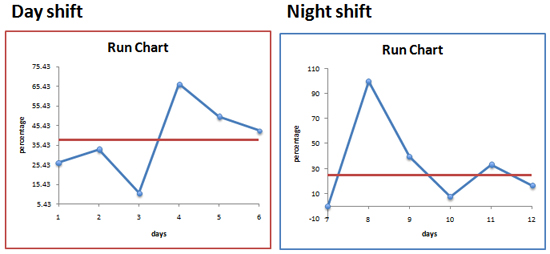
17. 2nd PDSA
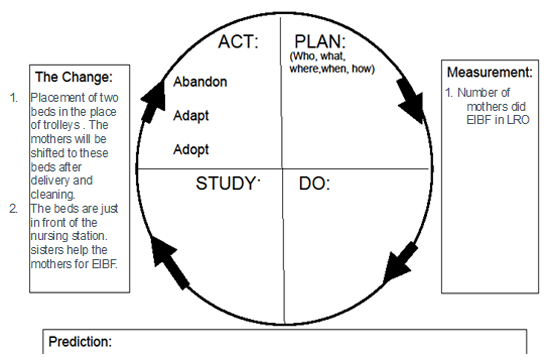
18. 2nd PDSA
2.3.17-22.3.17
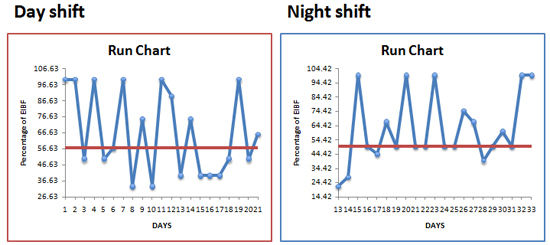
19. 2nd PDSA

20. 2nd PDSA

21. 3rd PDSA
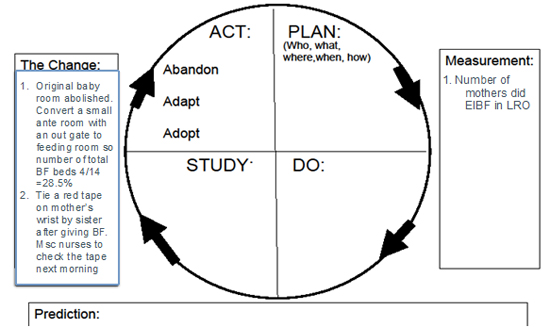
22. LDR

23. 3rd PDSA
PDSA(23.3.17-.14.4.17

24. 3rd PDSA

25. Final run chart day shift
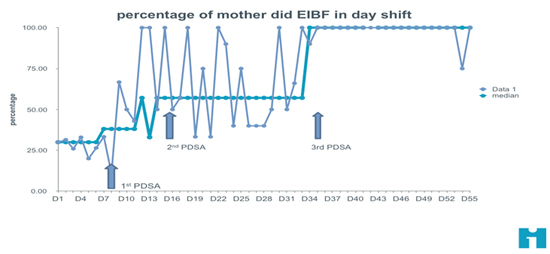
26. Final run chart night shift
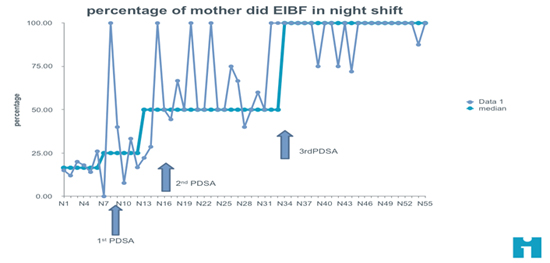
27. Final measurements
► Percentage of caregiver can tell the flowchart of delivery
correctly=100%
► Percentage of bed in LR earmarked for EIBF= 28.5%
► Percentage of outsider in LR at 12 midnight and 6 am- not
applicable , as the staff nurses could provide support to
ALL mothers for EIBF
28. Thank you

